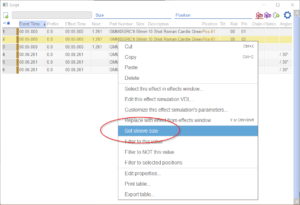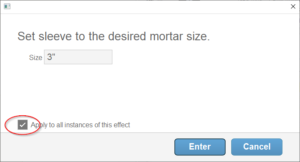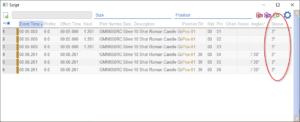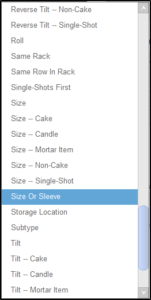Effects fit into racks of the same size that are also the right kind of rack, based on the effect’s “Type” field. Candles fit into candle racks. Single-shots fit into single-shot racks. Cakes fit into cake racks. Shells, mines, and comets fit into mortar racks. Obviously single-shots can also be shells, mines, or comets in the physical world, but effects have a single Type in the Finale 3D software, and that is what determines what kind of rack the effects fit into (see Why is ‘Type’ so important? What depends on it?).
In practice, you may have reason to put candles or single shots into your mortar racks, notwithstanding their Type. You may also want to put slice cakes in single-shot racks, or ground items or single-shots in cake racks.
The practice of putting single-shots and candles in mortars is called sleeving. Finale 3D extends the meaning of the term sleeving to include all circumstances of putting an effect into a rack of a different Type.
Table 1 – Using sleeving to put an item into a different kind of rack
| Original type of the effect | Original kind of rack that it goes into | Possible to “sleeve” the effect | Kind of rack the effect goes into if it is sleeved |
| single_shot | Single-shot rack | YES | Mortar rack |
| candle | Candle rack | YES | Mortar rack |
| shell, comet, mine | Mortar rack | YES | Mortar rack (no change) |
| cake | Cake or ground rack | YES | Single-shot rack (makes sense for slice cakes) |
| ground | Cake or ground rack | YES | Single-shot rack (example: ground strobe) |
| other_effect | None | YES | Single-shot rack |
To sleeve effects in Finale 3D, you simply set the “Sleeve” field of the effects to the size in the rack you want them to fit into. Then when you address the show or drag and drop pins in the rack layout view, the effects will fit into racks of the specified size, no matter what their actual Type and Size are.

Figure 1 – Example of six 2″ roman candles and some 3″ racks that would be nice to put them into.
The example shown in Figure 1 has six 2″ candle effects that do not fit into the 3″ mortar racks because of their Type and Size. Right-click on the effects in the script window to set their Sleeve field, as shown in Figure 2.

Figure 2 – Right-click the effects in the script to set their “Sleeve” field to 3″ to make them fit into 3″ racks.
The menu item will bring up the dialog shown in Figure 3. You can select multiple effects and right click on any of them to set the Sleeve of all of them at once, or if you know that you want to sleeve all similar effects in the entire show, you can right-click on any one of them and check the “Apply to all instances of this effect” box in the dialog.

Figure 3 – Check the “Apply to all instances of this effect” box to apply to all effects with the same part number.
The Sleeve field is one of the columns in the script table. It is hidden by default. From the blue gear menu you can unhide the column to look at the Sleeve values, as shown in Figure 4. Inches and millimeters are compatible representations for sleeving effects, so long as they are within a small tolerance. For example, 75mm and 76mm sizes both fit into 3″ rack tubes as well as 75mm and 76mm tubes.

Figure 4 – Unhide the “Sleeve” column to examine the sleeve field of the effects in the show, which are blank by default.
Having set the Sleeve fields to 3″, the empty racks shown in Figure 1 will hold the candles without errors when you re-address the show. Figure 5 shows the result after sleeving and re-addressing.

Figure 5 – After re-addressing, the candles with the 3″ sleeve fields will fit into 3″ mortars.
Sorting by size in the addressing dialog
The sorting fields in the addressing dialog include a number of options related to size, as shown in Figure 6. The sorting options that have the same name as a script column will sort by the unadjusted data value in that column. Thus the “Size” sorting option sorts the sizes without taking into account the sleeve size. The “Size — XXX” options just above the blue row in Figure 6 sort by size for specific effect types while doing nothing for effects of other types. The size and the effect type for those options refer to the “Size” and “Type” columns’ data values, unaffected by sleeving. With respect to these options, a 50mm single-shot is still a 50mm single-shot, even if you have sleeved it to go into a 3″ mortar rack.

Figure 6 – The size sorting options in the addressing dialog do not take into account sleeve size, except for the “Size Or Sleeve” option.
Slice cakes in single-shot racks
Sleeving changes the kind of rack that an effect is compatible with, and it changes the size of the mortar or tube or cake slot in the rack that the effect occupies, the changed size being the sleeve size. Some single-shot racks have a “Max. usable row length” constraint that limits the number of effects that can fit in a rack row by the sum of their sizes, which must not exceed the usable row length.
Sleeving changes the kind of rack that an effect is compatible with, and it changes the size of the mortar or tube or cake slot in the rack that the effect occupies, the changed size being the sleeve size. Some single-shot racks have a “Max. usable row length” constraint that limits the number of effects that can fit in a rack row by the sum of their sizes, which must not exceed the usable row length.
Cakes that are sleeved to go into single-shot racks are usually slice cakes comprising a single row of tubes. As a special mechanism, sleeved cakes will require and occupy an entire rack row if the rack has a “Max. usable row length” constraint, rather than consuming just part of the row length.
Imagine a slice cake that consists of 10 tubes with 1″ diameter. Its footprint is wide and rectangular, approximately 1o or 11 inches by 1″. If you put that slice cake in a single shot rack, the slice cake slides into the row, aligning length-wise with the row. It consumes 10 or 11 inches, not 1″.
Since a common practice is for slice cakes to consume entire rows of single-shot racks, the special mechanism for sleeving cakes implements just that — sleeved cakes consume the entire row of racks with “Max. usable row length” constraints. Thus to sleeve a 10 tube slice cake with 1″ tubes into a single-shot rack you would typically use a sleeve size of 1″, not 10 or 11 inches. If the rack has a min/max size constraint, the 1″ will fit appropriately into the min/max range of the rack. If you want, you can cancel out the special mechanism and set an explicit row length consumption for a cake by settings its “rackRowLengthConsumption” property in the Physical Specifications column in the effects window (see Variable tube size racks with row length constraint).
Unlike single-shots and shells, cakes in Finale 3D are considered non-rotationally symmetric (see Why is ‘Type’ so important? What depends on it?). A shell doesn’t look any different if it is rotated inside the mortar, whereas a cake might. A sideways fan cake is different from a forward/back fan cake. A left-to right fan cake is different from the same cake rotated 180 degrees.
A slice cake needs to align with the row of the single-shot rack that contains it in order to fit, physically: a long, skinny slice cake fits into a long, skinny row. Because cakes are non-rotationally symmetric, their orientation in the show matters, and the rack that contains them must be oriented compatibly with the cake orientation. The actual requirement is that the sum of the cakes’ PAN and SPIN angles is required to match the orientation of the rows in the single-shot rack they are sleeved into, plus or minus 180 degrees. For example, if the slice cake is oriented facing forward such the fan faces the audience, the single-shot rack that it fits into needs to be rotated 90 or 270 degrees so that its rows are sideways, aligned with the forward-facing, wide, rectangular cake.
